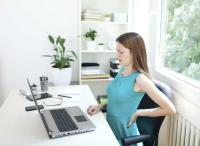 Add My Company
Add My Company
Sign In
Tips on How to Reduce Back Pain When Sitting
19-06-2019

Many people experience back pain when sitting but are relatively pain free when standing or moving around. This article covers the typical presentation of back pain which comes on when sitting, the likely causes, as well as tips for how to prevent and treat this type of back pain.
What is a typical presentation of someone who gets back pain when sitting?
Many of us have experienced back pain when sitting. Usually, this is after we’ve been sitting for several hours, concentrating on work or after watching a particularly long film or play, whether at home or in a theatre. Back pain is common in students and other whose work or hobby involves sitting at a desk, people who do large amounts of driving, people who spend hours at a computer gaming, as well as anyone who remains seated for prolonged periods of time, as might occur following a lower limb injury or during a long commute by train or plane.
Back pain when sitting might be felt in the low back, upper back or both. Pain typically starts as a ‘niggle’ and is not particularly distracting. However, over weeks and months, pain can become so bad that it affects daily activities, and it is not usually until we reach this point that we seek help.
This is the typical progression of back pain when sitting:
To begin, we are pain free when standing or walking but notice some discomfort in some part of our back following periods of prolonged sitting, perhaps 3-4 hours. This is not usually described as ‘pain’ but more of a ‘niggle’ or irritation. In many cases this niggle might only be noticed at the end of the week or the end of the day if sitting for long periods of time is part of our job. After getting up to get a coffee or go to toilet, for example, we might notice that the niggle has gone.
Over time – this could be weeks or months -- we start to experience back pain more frequently. Instead of it coming on at the end of a week of sitting, or at the end of the day, we start to notice it during the day. Getting up and moving around continues to ease the pain.
However, with the retention of a seated posture for many months, we begin to notice that not only has the niggle turned to pain, and that it comes on sooner, but that standing up, moving around or stretching no longer eases this. As soon as we return to a sitting position, pain quickly returns.
Eventually, back pain when sitting starts to become a problem, with the severity of pain increasing. We might take analgesics, find we are uncomfortable in our seat, with pain covering a wider part of the back than previously. We notice that we’re unable to get comfortable when sitting, and many people try using a different chair in the hope that this will ease their symptoms. Sometimes swapping chairs helps helps, but in many cases the pain simply returns.
It is not until back pain from sitting is commonplace and starting to affect our work or when we experience it even when we are standing and moving around, that treatment is sought.
What causes back pain when sitting?
There are different types of back pain and the cause of all of these is not known. Assuming a person is relatively well and has not suffered trauma to the back, back pain which comes on when sitting but not when standing and moving about is most likely caused by the retention of a static posture, irrespective of what that posture is. This is because sitting requires muscular effort, often in the form of isometric contraction, and prolonged isometric contraction causes pain. This type of back pain is sometimes referred to as postural strain.
No one would attempt to hold a house brick in an outstretched arm for a prolonged period of time, yet we often sit for hours on end, expecting the muscles of our back to support our sitting posture. Is it any wonder that they start to fatigue and become painful?
Sitting also compresses tissues of the spine and again, this may be one of the causes of back pain when seated for prolonged periods.
There are specific exercises that will help alleviate pain in each of these parts of the back, but in all cases, movement of the back is key to overcoming symptoms.
How to treat low back pain when sitting
The best way to ease back pain from sitting is to get up and walk around for a couple of minutes. Walking moves the pelvis and the pelvis moves the lumbar spine. Walking therefore helps to mobilize the joints of the low back but it also permits muscles of the back and pelvis to change length.
Best of all is to get up move before pain comes on, rather than trying to shake off the pain once it is established. For example, if pain comes on after sitting for 60 minutes, then advice would be to get up every 45-50 minutes.
The low back can be moved when sitting. For example,
simply pressing the low back into the back of the chair and then sitting up straight again, repeated 5 times. This causes the lumbar spine to move from a position of extension (sitting upright), to one of flexion (pressing the low back into the chair).
actively lifting one knee at a time, or temporarily using a foot rest. Lifting the knees brings about hip flexion, a posterior tilt in the pelvis, and slight lumbar flexion. This is likely to be helpful of a person has been sitting in and upright posture.
Twisting around in the chair whilst keeping the feet facing forwards helps mobilize the back into a rotatory movement. This also helps stretch muscle of the low back.
Hip hitching – raise one side of the pelvis at a time. This encourages lateral flexion of the spine.
Stretching the psoas muscle has been postulated to help alleviate low back pain as this muscle originates on the lumbar spine and it is argued that when sitting, psoas is held in a shortened position, pulling the lumbar vertebrae anteriorly. Stretching this muscle helps reduce tension in it, theoretically reducing pull on lumbar vertebrae.
Moving the spine when sitting is not as effective at reducing symptoms as getting up and moving around.
How to prevent or reduce upper back pain when sitting
Pain in the upper part of the back is also eased by movement of the spine. However, getting up and walking around doesn’t mobilize the middle, thoracic portion of the back or the upper part of the back as much as it does the lumbar spine.
Moving the shoulder blades as when performing rotatory movements of the shoulder, shrugging the shoulders or drawing the shoulder blades backwards 5 times or so is one way to alleviate upper back pain.
Performing neck stretches.
Moving the head and neck.
Movements of the head, neck and shoulders help alleviate tension in the trapezius muscle. This muscle is in the upper back. So movement of the head, neck and shoulders tends to ease pain arising from trapezius.
For many years the advice was to adopt a particular posture when sitting, in the hope that this would reduce the likelihood of us experiencing back pain. Working with a screen at eye level, and sitting with the hip and knees flexed to approximately 90 degrees, causes us to adopt an upright sitting posture. However, prolonged retention of this posture is likely to lead to back pain, just as is retention of a slumped posture, or a hunched posture. It is not known what is the ideal sitting posture.
As with treatment of low back pain from sitting, it is better to introduce movements of the head, neck and shoulders, and to change position of the upper back, before symptoms come up, rather than trying to shake them off once they are established.
Finally, the longer a person has been experiencing back pain from sitting, the longer it takes to resolve. This is because muscle that are required to support us when sitting become progressively fatigued and so stop functioning efficiently. Once way to ease both upper or lower back pain from sitting is with massage. This can be especially helpful as an adjunct to movement and stretching in cases where back pain has been established for several months.
For more information on Tips on How to Reduce Back Pain When Sitting talk to PAM Health
Enquire Now
List your company on FindTheNeedle.

